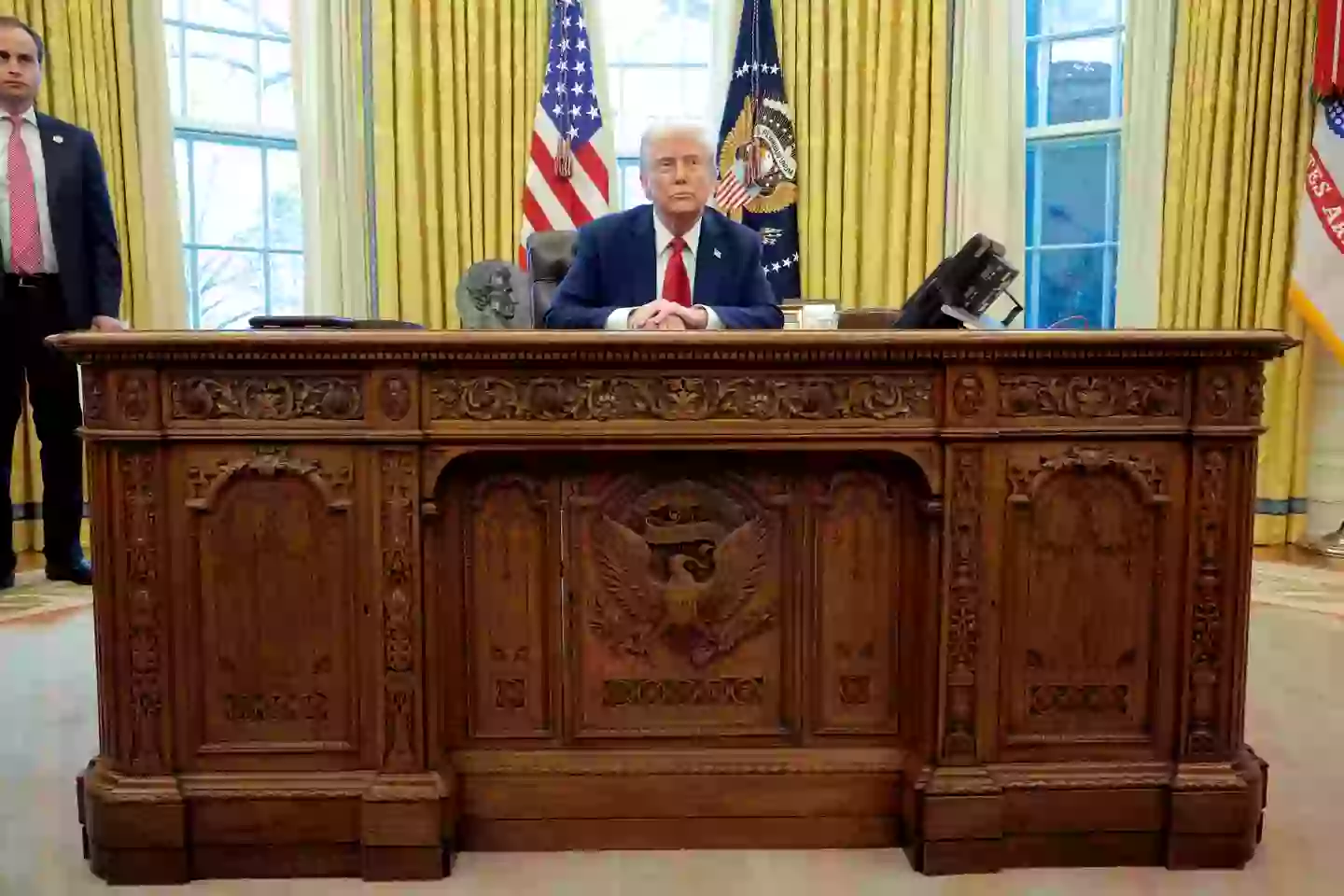Since returning to office last month, President Donald Trump has initiated a flurry of changes, ranging from policy shifts to even alterations in the interior design of the White House. In one of the more unexpected moves, the 78-year-old President announced that the historic Resolute Desk had been removed from the Oval Office and replaced—at least temporarily—with another well-known piece of furniture, the C&O Desk, while the original is undergoing a light refurbishment.
A Symbol of American Heritage
The Resolute Desk has long been a symbol of continuity and tradition in the White House. Crafted from timbers salvaged from the British exploration ship HMS Resolute, it was presented to President Rutherford B. Hayes by Queen Victoria in 1880. Over the decades, this iconic desk has been used by nearly every U.S. President, including recent occupants such as Barack Obama and Joe Biden. Its storied history and symbolic value have made it an object of national pride, revered for its craftsmanship and its connection to pivotal moments in U.S. history.
A Temporary Replacement: The C&O Desk
In a recent statement on Truth Social, President Trump explained that the Resolute Desk had been removed and was scheduled for a series of refurbishments. In its place, a “beautiful but temporary” replacement—the C&O Desk—has been installed. This desk, familiar to many due to its use by former President George H.W. Bush and other predecessors, will serve as the interim centerpiece of the Oval Office while the Resolute Desk receives a “vital” refresh.

In his post, Trump noted, “A President, after election, gets a choice of 1 in 7 desks,” although he humorously clarified that in reality, there is a choice of one in six. He continued, “This desk, the C&O, which is also well-known and was used by President George H.W. Bush and others, has been temporarily installed in the White House while the Resolute Desk is being lightly refinished—a vital job. This is a beautiful, but temporary replacement!”
A Curious Timing
What makes this decision particularly intriguing is its timing. The announcement came just days after an incident involving Elon Musk’s four-year-old son, commonly known as “Little X” (whose full name is X Æ A-12), during a recent visit to the White House. According to multiple reports and photographs circulating in the media, during a Q&A session about the Department of Government Efficiency (DOGE), the young boy was seen fidgeting, babbling, and, notably, engaging in a rather unsavory act. At one point, he was observed picking his nose and then apparently using it to wipe a part of the desk’s surface.
The New York Post reported that this incident was among the factors that sparked discussion on social media about the need for refurbishments to the venerable desk. While some critics on the internet joked about the incident—suggesting that the desk was already showing signs of wear from the mishandling—it is unclear whether the behavior of Musk’s son was the direct reason behind the decision. Nevertheless, the timing of the refurbishment announcement, coming just days after the incident, led many to draw a connection between the two events.
Public Reactions and Social Media Buzz
The incident involving Musk’s son quickly became a trending topic on social media. Users expressed a range of opinions, from humorous critiques to serious debates about the appropriateness of bringing children into high-level governmental meetings. Comments ranged from ironic amusement at the idea that even iconic pieces of furniture can be affected by the behavior of a toddler, to more critical perspectives on parental responsibility and decorum in the political sphere.
One commenter noted, “I noticed the top was looking worn out when he was doing all his signing. It was due with or without the kid’s snot.” Another questioned the wisdom of bringing an unruly child into such a formal setting, while yet another remarked that they, too, would have replaced the desk under such circumstances. This mix of levity and criticism reflected the broader public’s engagement with the incident—a testament to the pervasive influence of social media on shaping narratives around even the most traditional symbols of American government.
Trump’s Flurry of Executive Orders and Broader Reforms
This interior design change is just one facet of the sweeping changes that President Trump has implemented since his return to office. In his first 100 days, Trump signed an unprecedented 73 executive orders—the highest number in more than 40 years for a president during this period. These orders have spanned a wide range of issues, signaling a determined effort to reshape policy and reassert his administrative priorities.
The decision to refurbish the Resolute Desk, while perhaps seeming minor in the grand scheme of executive governance, fits within this broader narrative of transformation and renewal. It is emblematic of a leader who is not afraid to make bold decisions—even in areas as symbolic as the furnishings of the Oval Office. To some, it represents a break with tradition, a willingness to challenge the status quo. To others, it is simply another example of the President’s distinctive style and his focus on immediate, tangible changes.
The Historical Significance of the Desk
The Resolute Desk is more than just a piece of furniture—it is a living artifact of American history. Over the decades, it has witnessed countless presidential decisions, policy debates, and historical moments that have shaped the nation. From its creation in the late 19th century to its presence in modern times, the desk has been a silent observer of the evolution of American politics.
Its removal and refurbishment raise intriguing questions about the preservation of historical symbols in a rapidly changing political landscape. Some traditionalists argue that altering such an iconic object could be seen as a disservice to the legacy of past presidents. Others suggest that modern leadership requires periodic renewal—even of the objects that define our national heritage.
Balancing Tradition and Innovation
President Trump’s decision to temporarily replace the Resolute Desk with the C&O Desk while it undergoes refurbishments is a bold statement about balancing tradition with the need for modernization. It underscores the idea that even the most enduring symbols can, and sometimes must, evolve in response to new realities. The C&O Desk, with its own distinguished history, provides a bridge between the past and the present—a reminder that while the historical significance of the Resolute Desk is undeniable, there is also room for practical updates in an ever-changing world.
In his remarks on Truth Social, Trump hinted at the idea that every president has the unique privilege of choosing a desk that best reflects their style and priorities. In making this decision, he not only addressed a practical need—a broken piece of furniture that was no longer meeting the demands of daily use—but also sent a broader message about his approach to governance. It was a clear signal that he was willing to disrupt established norms in order to pursue what he saw as necessary improvements, no matter how unconventional those changes might appear.
Looking Forward
As the Resolute Desk is scheduled to undergo refurbishments, its temporary replacement will continue to serve as the focal point of the Oval Office. The upcoming renovations promise to restore the desk’s former glory, potentially incorporating modern touches while preserving its historical essence. For a President who has embraced change in many aspects of his administration, this move is consistent with a broader vision of reimagining and reinvigorating the tools and symbols of executive power.
The connection between this refurbishment and the recent controversy involving Elon Musk’s son remains a subject of public speculation and debate. While it is difficult to determine whether the behavior of a four-year-old had any direct influence on the decision, the close timing of these events has certainly added an element of intrigue to the story. What is clear, however, is that the incident has sparked a wider conversation about the intersections of tradition, modernity, and the sometimes unpredictable impact of social media on our cultural institutions.
Conclusion
In the grand tapestry of American history, the Oval Office is a central symbol—a space where the nation’s most critical decisions are made. The Resolute Desk, with its storied past and symbolic significance, has long been an integral part of this environment. President Donald Trump’s decision to remove the desk and replace it temporarily with the C&O Desk, while undergoing much-needed refurbishments, is more than a mere change in interior design. It is a reflection of a leader who is unafraid to challenge convention and to make bold moves that resonate far beyond the walls of his office.
As we await the return of the refurbished Resolute Desk, we are reminded that even the most iconic symbols are subject to change, and that true leadership often requires balancing the weight of history with the demands of the present. Whether one views this decision as a break with tradition or as a necessary evolution, it stands as a testament to the dynamic and ever-changing nature of American governance.
I invite you to share your thoughts on this development. What does the removal of the Resolute Desk signify for you? How do you feel about the balance between preserving historical artifacts and embracing modernity in the highest office of the land? Please leave your comments below and join the conversation.

Sophia Rivers is an experienced News Content Editor with a sharp eye for detail and a passion for delivering accurate and engaging news stories. At TheArchivists, she specializes in curating, editing, and presenting news content that informs and resonates with a global audience.
Sophia holds a degree in Journalism from the University of Toronto, where she developed her skills in news reporting, media ethics, and digital journalism. Her expertise lies in identifying key stories, crafting compelling narratives, and ensuring journalistic integrity in every piece she edits.
Known for her precision and dedication to the truth, Sophia thrives in the fast-paced world of news editing. At TheArchivists, she focuses on producing high-quality news content that keeps readers informed while maintaining a balanced and insightful perspective.
With a commitment to delivering impactful journalism, Sophia is passionate about bringing clarity to complex issues and amplifying voices that matter. Her work reflects her belief in the power of news to shape conversations and inspire change.
